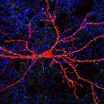Longer-term outcomes of program to reduce unnecessary antibiotic prescriptions
2014-10-10
(Press-News.org) The initial benefits of an outpatient antimicrobial stewardship intervention designed to reduce the rate of inappropriate antibiotic prescriptions were lost after discontinuation of audit and feedback to clinicians, according to a study published in JAMA. The study is being released early online to coincide with the IDWeek 2014 meeting.
Antibiotics are the most frequently prescribed medications for children; most are prescribed for outpatient acute respiratory tract infections. Because antibiotic prescribing is often inappropriate, Jeffrey S. Gerber, M.D., Ph.D., of Children's Hospital of Philadelphia, and colleagues recently conducted a randomized trial of an outpatient antimicrobial stewardship intervention that found a nearly 50 percent relative reduction in prescribing rates for broad-spectrum antibiotics, according to background information in the article.
To assess the durability of this intervention, the researchers followed antibiotic prescribing across intervention and control sites after termination of audit and feedback. The randomized trial was conducted within 18 community-based pediatric primary care practices using a common electronic health record. The intervention included clinician education, comprising a 1-hour review of current prescribing guidelines for the targeted conditions; and audit and feedback of antibiotic prescribing. Nine practices received the intervention and 9 practices received no intervention. Twelve months after initiating the study, the researchers stopped providing antibiotic prescribing audit and feedback to clinicians in the intervention group. As planned prior to the end of the intervention, the observation period was extended by an additional 18 months, bringing the total observation time to 50 months.
As previously reported, following the 12-month intervention of prescribing audit and feedback, broad-spectrum antibiotic prescribing decreased from 26.8 percent to 14.3 percent among intervention practices vs 28.4 percent to 22.6 percent in controls. Following termination of audit and feedback, however, prescribing of broad-spectrum antibiotics increased over time, reverting to above-baseline levels. After restandardization of the data set for the additional 18 months of data, antibiotic prescribing increased from 16.7 percent at the end of intervention to 27.9 percent at the end of observation in the intervention group and from 25.4 percent to 30.2 percent in controls.
"These data suggest that audit and feedback was a vital element of this intervention and that antimicrobial stewardship requires continued, active efforts to sustain initial improvements in prescribing. Our findings suggest that extending antimicrobial stewardship to the ambulatory setting can be effective but should include continued feedback to clinicians," the authors write.
INFORMATION:
doi:10.1001/jama.2014.14042
Please see the article for additional information, including other authors, author contributions and affiliations, financial disclosures, funding and support, etc.
ELSE PRESS RELEASES FROM THIS DATE:
2014-10-10
The so-called Signal Transducers and Activators of Transcription, or STATs, are key components of many different signalling pathways. Not surprisingly, then, when something goes wrong with their regulation the consequences can be severe and many types of cancer are known to be associated with increased activities of one or more STAT protein. STAT3 is a frequent culprit and is often found to be activated in tumour cells.
Considerable efforts are going into developing inhibitors of STAT3 for use in cancer therapy but it is unclear whether these will turn out to be suitable ...
2014-10-10
New research out of Queen's University could give insight into what terrorists are thinking. Professor David Skillicorn (School of Computing) analyzed language used in two jihadist magazines to gain intelligence about terrorist strategy.
He examined the language used in Inspire, an online magazine reportedly published by al-Qaida in the Arabian Peninsula, which aims to increase the availability of their message, and the Islamic State News published by ISIS. Inspire has attracted attention because of its goal of attracting lone-wolf attacks in Western countries.
"The payoff ...
2014-10-10
The immunosuppressive drug fingolimod (trade name: Gilenya) was approved for an expanded therapeutic indication in May 2014: It is now also available for adults with highly active relapsing remitting multiple sclerosis (RRMS) who had received other pretreatment than interferon beta (IFN-β). In an early benefit assessment pursuant to the Act on the Reform of the Market for Medicinal Products (AMNOG), the German Institute for Quality and Efficiency in Health Care (IQWiG) examined whether the drug offers an added benefit over the appropriate comparator therapy in this ...
2014-10-10
A previously unknown mechanism through which the brain produces new nerve cells after a stroke has been discovered at Lund University and Karolinska Institute in Sweden. The findings have been published in the journal SCIENCE.
A stroke is caused by a blood clot blocking a blood vessel in the brain, which leads to an interruption of blood flow and therefore a shortage of oxygen. Many nerve cells die, resulting in motor, sensory and cognitive problems.
The researchers have shown that following an induced stroke in mice, support cells, so-called astrocytes, start to form ...
2014-10-10
A novel technique which reduces image degradation caused by respiratory motion during a PET scan was developed in a recent study at the University of Eastern Finland. PET scanning is routinely used to detect cancer and heart conditions. The new technique presented in the PhD thesis of Tuomas Koivumäki, MSc (Tech.), is based on bioimpedance measurement and it allows for image reconstruction at a specific phase of the patient's breathing pattern. This, in turn, makes it possible to reduce image degradation caused by motion.
In the future, the newly developed technique ...
2014-10-10
New Orleans, LA – A special study using data from LSU Health New Orleans School of Public Health's Louisiana Tumor Registry has found that colorectal cancer incidence rates in the Louisiana Acadian parishes are among the highest in the United States. This study appears to be the first to identify a high rate of cancer in a large, regional, US founder population, raising the possibility of a genetic predisposition. Alternatively, an unidentified, robust environmental risk factor may be present. The paper is published online in Clinical and Translational Gastroenterology, ...
2014-10-10
A small, "empty" space teeming with activity: a synapse is a complex structure where the neural (electrical) signal from the presynaptic neuron, as it travels towards its target –a muscle, a gland or another neuron – turns into a chemical signal capable of crossing the synaptic space before becoming electrical again once on the other side. A synapse is a "dynamic" space not only because of the endless work that goes on there, but also for its ability to change its action over time (synaptic plasticity) as a result of either normal physiological processes (e.g., ...
2014-10-10
The sanitation intervention delivered under the terms of the Government of India's Total Sanitation Campaign—the world's largest sanitation initiative—provided almost 25 000 individuals in rural India with access to a latrine. However, it did not reduce exposure to faecal pathogens or decrease the occurrence of diarrhoea, parasitic worm infections, or child malnutrition.
"The programme is effective in building latrines, but not all households participate"*, explains lead author Professor Thomas Clasen from Emory University, Atlanta, USA and the London School ...
2014-10-10
VIDEO:
Dr. Myron M. Levine, Director of the Center for Vaccine Development at the University of Maryland School of Medicine describes the Ebola vaccine testing taking place in Mali, West Africa.
Click here for more information.
Professor Myron M. Levine, MD, Director of the Center for Vaccine Development (CVD) at the University of Maryland School of Medicine (UM SOM), and UM SOM Dean E. Albert Reece MD, PhD, MBA, announced today that the CVD, in conjunction with its sister institution, ...
2014-10-10
LA JOLLA, CA – October 9, 2013 - Scientists at The Scripps Research Institute (TSRI) have created a synthetic molecule that mimics "good" cholesterol and have shown it can reduce plaque buildup in the arteries of animal models. The molecule, taken orally, improved cholesterol in just two weeks.
This research, published in the October issue of Journal of Lipid Research, points scientists toward a new method for treating atherosclerosis, a condition where plaque buildup in the arteries can cause heart attacks and strokes.
"Atherosclerosis is the number one killer ...
LAST 30 PRESS RELEASES:
[Press-News.org] Longer-term outcomes of program to reduce unnecessary antibiotic prescriptions



